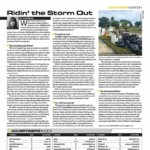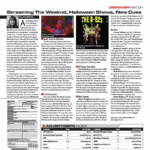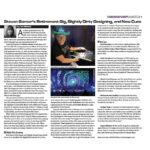The ABC-TV’s hit series Nashville interlaces the grit and glamor of rising country stars with the politics of record labels and romance. The story line is fictional, but behind the scenes, the touring industry’s experts are supporting the fictional music stars in a true-to-life way. LD Steve Fallon started lighting the performances for the second season, which finished airing in May.
“This has been an amazing ride of 22 episodes using every piece of new technology that rock ‘n’ roll has to offer for prime time TV.”
He explains, “The show shoots an episode every nine days, with two to three live performances, either on location or at a purpose-built sound stage in Nashville. Lighting the performances is mapped out when we do a site survey, usually a week before the shoot, with notes from the DP Michael Lohmann. We then plan the events.”
Season highlights come to mind. Episode 211 was shot during three days in March on the Sabre Army Airfield at Fort Campbell, KY. The story line featured a charity concert on the post, and the military even played a role as extras and more. “The episode had six Apache Helicopters fly over and land backstage, and included Michelle Obama live from the White House on the video screens.” The recent series finale moved to Nashville’s LP Field stadium, the setting for one character’s performance of a record launch concert. Fallon’s lighting list racked up close to 600 moving fixtures. “Think Super Bowl look,” he said. A stormy April presented challenges. “The shoot took 18 hours to capture, with a five-day load-in. We raced the clock until daylight right down to the final scene. The weather further hampered the setting up time. We had to cancel the two nights set aside for focus and programming due to rain and high winds. The only thing that saved the day was the work done in ESP Vision, programmed at the VER shop with Dave “Fugie” Convertino.
“The next challenge was filling the field with haze (from 44 hazers) and hoping the wind would subside,” Fallon continues. During that night, “the weather gods were kind and gave us the perfect setting. Because the budget did not extend to 70,000 people filling the stadium, we used Glow Motion Technologies to give the illusion of that number of fans.” For a video clip showing highlights from Episode 222, go to plsn.me/ABCNashville222.
Fallon followed the Nashville finale with Barry Gibb’s U.S. tour, May 15-June 4. Barry, the sole survivor of the legendary BeeGees group, includes family members with son Stephen on guitar and vocals, daughter Ali working the teleprompter and brother Maurice’s daughter Sami on vocals. While Gibb included musical tributes to his late brothers, he offered surprising numbers in his repertoire, including a Bruce Springsteen song at the Boston Garden. For a video, go to plsn.me/GibbCoversSpringsteen.
 TV Studio Design: From Set Fabrication to Fabulous Lighting
TV Studio Design: From Set Fabrication to Fabulous Lighting
With 26 years in the entertainment lighting industry, LD Christian Choi has followed his design passion to the world of TV studios. For the past 15 years, he’s been working as a studio production and lighting designer, and a decade ago, he wove in work as a scenic fabricator. Since 2004, he’s completely designed a few studios including the SBTN (Saigon Broadcasting TV Network) news and SET (Saigon Entertainment Television) news and talk show studios set and lighting, both in Garden Grove, CA. More recently, he finished two new studios for broadcast group KVLA in Huntington Beach, CA.
As a designer and fabricator, he designs the scenic elements, makes the sets, welds and paints it and, for further enhancement, also creates the lighting design and any video elements needed to complete the look.
 “Sometimes, I end up getting into the nitty gritty of it, sanding and grinding,” he says. “There is nothing like grinding down steel, sparks flying everywhere. It can be quite satisfying.”
“Sometimes, I end up getting into the nitty gritty of it, sanding and grinding,” he says. “There is nothing like grinding down steel, sparks flying everywhere. It can be quite satisfying.”
Choi’s foray into studio design was a happy accident. Though he studied scenery in school, his path led to lighting live TV events, and DVD shoots, concert touring, theatre and corporate gigs. But one day in 2004, a DVD producer friend asked his help revamping his TV studio news lighting and set. That led to designing and fabricating scenery, building a scene shop and even constructing his own CNC (computer numerical control cutting) machines. He doesn’t do it alone. He had welders, tubing benders, paint shop, and other tools onsite to make it all happen, and he credits the crew at his company, Emergent Entertainment Group, LLC, for their efforts as well. The company has been operating since 2002.
Here’s how the CNC works: when a CAD drawing is fed into it, the computer converts the design into numbers. The numbers are the coordinates of a graph, which controls the robotic cutter, directing it to follow the shape of the design.
“I built a large-scale production CNC machine — the second of two actually that I own — and have been making fascinating strides in computer-aided manufacturing (CAM) technologies and CAD drafting for fabrication for my works. CAD and CAM is a passion for me. It’s mainly engineering paraphernalia, but I’ve always been fascinated with it.”
A math freak, Choi loves the “magical” precision of CAD/CAM technology. “I’m hypnotized by how mathematics and natural algorithms can be expressed in patterns which can be so perfectly realized with CNC and wood, or plastics, foam and metals. It’s astonishing where this is all heading.”
While TV studio design is more static and intimate than live events, he said, there are two things to design for: the closeup, and the backgrounds, both in balance with one another. As there is no movement of performers — mostly people seated for news or talk shows — “it creates fantastic opportunities to light people and design sets quite surgically with more conventional modifiers and fixtures that can enhance the overall look, photographically.”
For those who want to venture into this field, Choi advises deep research into TV, photographic and film studio lighting equipment, with an emphasis on cameras, irises, lenses, sensor types and the camera control unit (CCU). “Even the bandwidth from the studio to the broadcaster counts. In other words, it doesn’t help driving a Lamborghini in a city with a 40 mph speed limit. There are so many factors downstream of the lighting, which can completely flaw it. A DP’s best friends are CCU and the broadcast company technical rep.”
He’s inspired by the convergence of TV, film and photography technologies. “Now 4K video is approaching the resolution that digital photography used to be a few years ago — this is an incredible technological triumph!”
Choi is also intrigued with the advances in LED studio lighting. “There are some incredible and TV-considerate LED studio lighting fixtures that have been coming (to market) over the past few years. It’s incredible how much subtlety and nuance you can conjure up with your fixture types and modifiers on camera. My philosophy remains, never skimp on key lighting, though some budgets don’t allow for the absolute best.”
But Choi hasn’t abandoned the concert industry’s automated lighting fixtures, using these for band performances on talk shows or for backgrounds to reduce manual focusing.
“After 25 years of lighting and having little physically tangible to show for a design besides DVDs or video, it’s gratifying when you can hold your scenic designs in your hands — it’s not just visual vapor. I’ve always been enchanted by production designers such as Jeremy Railton, Mark Fisher and Gemma Jackson. They must have had hallways in their houses amassing pieces from their works from far corners of the globe that would’ve otherwise been thrown out.”
He hasn’t lost his love for music-oriented events. Retracing his path in the industry, he points out how playing in a blues band led to work as a spotlight operator in a hotel variety show in 1988, which he operated via a foot pedal while playing. “Lighting resonated with my musical senses and I was good at it.” He progressed to programming automated lighting, then to visuals, TV lighting design, and now scenic design.
“I planned to be a musician, but lighting had paved a much brighter future for me at the time, and it really kind of spiraled upward quickly for me. So I stayed with it and have had an interesting life because of it.”
Helping Choi on the KVLA Studios team were Luisa Wong, Art Director & Administration; Thomas Folden, Lead Carpenter & Director of CNC; Shawn Shannon, Lead Engineering/Metalworks; Kevin Do, House Lighting Director; Fernando Accosta, Head Electrician/LED Practicals; Labor — Scott Ramey; and Executive Producers Jenny and Cindy Ho.
Debi Moen tuned into TV production for this month’s Designer Watch but will be switching back to live concert tours in July and August. Send her your news via email: dmoen@plsn.com.


